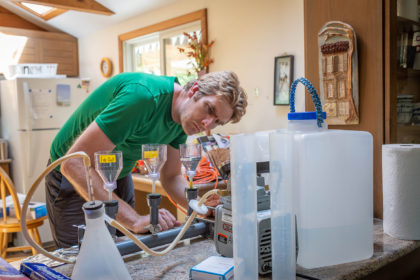Professor Nathan Ahlgren offers advice on pond safety in wake of toxic blooms

Water that contains cyanobacteria, or blue-green algae, can pose serious health concerns to humans and animals alike. Clark biology professor Nathan Ahlgren has encountered cyanobacterial blooms in waters where he and his students have conducted research.
“I think generally that all ponds are at risk of cyanobacterial blooms,” Ahlgren says.
Fortunately, Worcester has a citizen science program in place, run by Clark alum Jacquelyn Burmeister ’16, that monitors pond health and cyanobacteria across multiple ponds, including those that don’t have city beaches.
Still, it’s important to be aware of what to do in the event that you, or your pet, comes into contact with toxic algae. Professor Algren answers some questions about cyanobacteria below.
What can happen if a person — or animal — goes into waters contaminated with toxic algae?
Toxic cyanobacteria can produce a variety of toxic compounds, but most often they make toxins that damage the liver. The biggest risk comes from ingesting water with the cyanobacteria, but exposure to the skin can cause a rash or blisters. While not as common, some blooms can produce potent toxins that can cause severe neurological problems.

Dogs are particularly at risk because they will often drink pond or lake water, and because they weigh less, it takes less toxin to affect them than it does humans. Animals are also at risk of exposure if they swim in contaminated water then ingest the toxins when they lick their fur. If you or a pet are exposed, the best action is to bathe with plenty of water and soap to remove any possible toxin.
How can I protect myself and my pets?
The best policy is to avoid drinking, swimming, or playing near water that may be contaminated. If you see water that is visibly blue-green in color or see large floating mats or scum from algae, it’s best to avoid that water. Not all algal blooms are caused by cyanobacteria or are toxic, of course, but if in doubt, it’s best to stay away. Fish can accumulate toxins, so it is best to avoid eating fish from waterways that have had a toxic bloom.
How long does it typically take for authorities to test and take measures to make the water safe again?
Testing for toxin levels can take one to a few days, but visual inspection of a water body for the presence of blue-green slicks or rafts of cyanobacteria can be a quick indicator to authorities that there may be a problem. If you are interested in helping to investigate or report a possible bloom, you can download and use the bloomWatch app from the EPA.
Treatment of the water to remove the bloom and/or toxins is more difficult, and the easiest solution is to let the bloom die out and resolve itself naturally. It can take days, or even weeks, for blooms to end and for the water to become safe again. Worcester actively treats ponds and lakes with chemicals to keep cyanobacteria at bay. These include places like Indian Lake and Coes Pond that frequently have exhibited blooms in the past.
Why this is happening? Is this typical, more frequent these days?
The causes of toxic cyanobacterial blooms are complex, but increased input of nutrients in waterways, known as eutrophication, is a frequent cause of toxic cyanobacteria blooms. Runoff from agriculture or home fertilizers, or leaching from septic systems, are common sources of nutrients that can stimulate cyanobacterial blooms. There is growing evidence that these bloom events are occurring more frequently, and there are stories of blooms occurring in waterways that haven’t seen them in the past. Toxic cyanobacteria grow better in warmer temperatures, and toxic blooms mostly occur during warm weather in the summer. Warming temperatures from global climate change are thought to increase the risk for such toxic events — so without mitigation, it is reasonable to expect an increase in cyanobacteria bloom events in the future. In addition, the strong rain events we have seen this summer frequently stimulate blooms because the strong burst of runoff they make often flushes nutrients into ponds and lakes.


